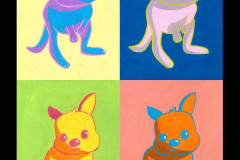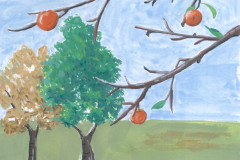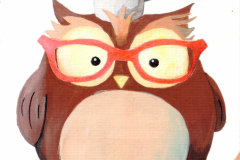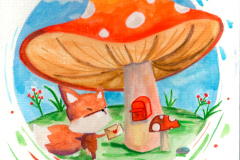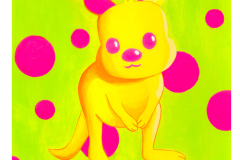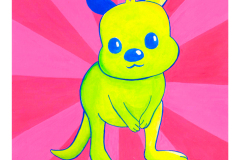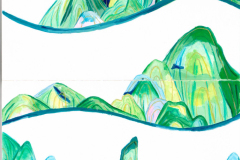Introduction
Concept art plays a vital role in bringing imaginative ideas to life before a film, video game, or animation reaches its final form. Environment concept art defines the visual atmosphere and setting for a project, setting the tone and immersing the audience in believable worlds. You will see how environments create context and mood for science fiction stories. Creating futuristic worlds means combining natural surroundings with imaginative technological elements. Gouache, a painting technique known for vibrant and opaque colors, provides unique textures and depth for these visuals. Artists like Simon Stålenhag influence the genre with their retro-futuristic and atmospheric digital paintings, blending reality with speculative technology.
Understanding the tools and processes behind futuristic gouache environment concept art helps you appreciate the craft and inspires you to approach your projects with fresh eyes. This article covers the history and purpose of environment concept art, compares traditional and digital techniques, and explains how gouache enhances sci-fi visuals. We explore the creative workflow, key elements to consider, and how these artistic decisions impact storytelling. Finally, you will find insight into integrating futuristic designs into sci-fi worlds, making your concepts both believable and captivating.
Understanding Environment Concept Art
Definition and Purpose
Environment concept art shows the places where stories happen. It gives a clear image of settings in films, video games, and animations. You use it to establish mood and background before creating the final scenes. In science fiction, it helps set the stage for worlds unlike our own, making strange ideas believable. This art guides teams by offering a vision of time, place, and atmosphere. Without it, creators would struggle to keep a consistent look or feel. Think about a sci-fi film with alien cities or distant planets. Environment art sets the tone for those scenes and directs the story visually. Could your imagination bring these new worlds to life without these visual guides?
Relationship to Other Art Forms
Environment art focuses on places, while character art captures people and prop art designs objects. Your challenge with environment art is bigger—it involves vast spaces and complex details. Unlike characters, environments show mood through light, color, and structure. Storyboards break down scenes into actions but lack detailed backgrounds. Environment art builds a world you can explore visually and emotionally. It requires planning both far-off views and close-up textures. Have you noticed how a well-designed setting can pull you deeper into a story? That’s environment art working together with characters and props to build a full experience.
Overview of Gouache as an Artistic Medium
Gouache painting uses water-based pigments combined with a binding agent like gum arabic. It stands out because of its opacity. This helps artists block out mistakes and layer colors without losing brightness. The paint dries to a matte finish, which reduces glare under different light sources — a useful trait for sharing environment concepts.
Concept artists appreciate gouache for its vibrant colors that look rich and solid. You can achieve both smooth gradients and textured brushstrokes depending on how much water you add. This flexibility allows you to capture the look of futuristic landscapes with depth and detail by hand.
Unlike transparent watercolor, gouache holds its color well on thick paper, making it easier to create sharp edges and bold shapes. Compared to digital tools, gouache offers a tactile experience and unpredictable textures that can inspire unique creative choices. Have you tried mixing both gouache and digital methods to get the best of both worlds?
Properties of Gouache Paint
Gouache paint is known for its solid coverage. It hides any previous layers beneath, allowing you to revise your work quickly. This opacity is perfect for environment art where you need clear, distinct areas like lighting, shadows, or architectural forms.
The paint dries with a matte finish, which means it avoids shiny spots. This helps present your environment concepts without distracting reflections. Texture control is another key property; you can apply gouache thickly for a rough surface or thin it down for smooth washes.
Since it responds well to layers, you can build complex scenes step-by-step. This feature supports sci-fi environments where details like glowing effects, mist, or weathering are important. Can your current medium achieve that same balance of control and expressiveness?
Gouache Compared to Other Mediums
Watercolor is translucent, producing light and airy effects best for natural landscapes or loose sketches. Gouache, by contrast, favors bold, sharp visuals that work well for futuristic settings with clear shapes and solid forms.
Digital tools offer endless adjustments and quick fixes. They excel when speed and edition matter. However, digital art can sometimes feel flat or overly uniform. Gouache adds variety through its texture and human touch, which helps environments feel lived in.
Choosing between gouache, watercolor, or digital depends on your goal. If you want precise, graphic sci-fi designs with a handmade look, gouache fits well. For softer or experimental backgrounds, watercolor works fine. Digital suits fast iteration and animation-ready assets. How does your workflow change when switching mediums?
Futuristic Design Elements in SciFi Worlds
Sci-fi environments often use specific design elements that shape how you see their world. Advanced technology appears everywhere, from floating vehicles to holographic interfaces. These gadgets show how far society has evolved and hint at the story’s possibilities.
Unusual architecture stands out with sharp angles, towering skyscrapers, or organic shapes that don’t exist in today’s cities. These structures push your imagination toward new ways people might live or work. They help you understand the culture and values of the society in that world.
Atmospheric effects complete these settings. Fog, neon glows, or distant storms create a sense of mood and place. These visuals guide how you feel about the scene and can suggest danger, mystery, or hope.
How do these parts of design help you connect to a new world? They provide clues about the environment and its history. Your role as an artist is to carefully choose these elements to support the story you want to tell.
Technology and Architecture
Futuristic technologies often shape the visual style of sci-fi environments. Buildings might use materials that seem to pulse with energy or change shape to fit different needs. These technologies can reveal the level of advancement in the story’s world.
Architecture in sci-fi frequently shows innovation. Imagine structures that hover above the ground or cities layered vertically to save space. These designs influence how people move and interact, which drives the plot.
The presence of technology and unique architecture often reflects social trends and power dynamics. When you design these elements, think about how they impact daily life and how characters would respond.
Atmosphere and Mood
Lighting is a powerful tool in setting the mood. Bright, cold lights suggest a sterile or controlled environment, while soft, colored glows can make a scene feel mysterious or otherworldly.
Weather and environmental effects add another layer to the atmosphere. Acid rain, swirling dust storms, or shifting weather patterns create a sense of challenge or change. They also help place your world on a believable planet or space setting.
These effects do more than decorate the scene—they shape your audience’s emotional response. When you adjust these elements, ask yourself how the mood supports the story’s themes and purpose.
Combining Traditional and Digital Techniques
Creating detailed environment concept art for sci-fi worlds often involves blending traditional gouache painting with digital tools. You start with physical media to capture textures, colors, and brushstrokes that feel organic. The tactile process lets you experiment with layers, shapes, and details directly on paper. Once your gouache painting reaches a solid stage, scanning or photographing it brings the artwork into digital space.
Digital software allows you to enhance and refine your physical piece. You can adjust colors, add highlights or shadows, and correct any small mistakes without losing the authentic feel of gouache. This hybrid approach offers flexibility and speed. It also helps you explore variations without starting from scratch. Combining techniques gives you the best of both worlds – rich texture from gouache and precise control from digital editing.
Traditional Gouache Workflow
You begin with basic sketches to plan composition and forms on paper. Then, you block in large shapes with thin gouache layers, focusing on color harmony. Gradually, you build details using thicker paint, layering tones to create depth and texture.
Drying times in gouache let you control blending but require patience. You can rework areas easily because gouache is opaque and rewettable. After defining main elements, add finer details like reflections, patterns, or light glows. Final touches involve balancing the piece visually and ensuring the scene communicates the intended mood or story.
Integrating Digital Tools
Once your gouache artwork is digitized, use painting software to tidy edges, fix small errors, and sharpen details. Digital brushes can simulate effects difficult to achieve traditionally, such as lens flares or subtle glows. Color adjustment tools help you fine-tune hues and contrast, aligning the environment with the sci-fi theme.
Layering in digital programs lets you isolate parts of the image without affecting the whole. This way, you can experiment with lighting or add atmospheric effects. Digital masks help manage complex edits while preserving the integrity of your gouache textures. How might you use these tools to push your environment designs further?
Creative Process of Environment Concept Art
Creating environment concept art starts with a clear plan. You begin by gathering references and learning about the world you want to build. This step helps you understand shapes, colors, and textures that fit your futuristic sci-fi setting. You might study architecture, nature, technology, or even space exploration images. This mix gives your work a strong foundation and invites unique ideas.
Sketching multiple thumbnails allows you to test ideas quickly. Try different compositions and elements without aiming for perfection. This stage encourages bold choices and prevents early commitment to a single idea. You can ask yourself: What mood does each sketch create? Which design fits the story best? This reflection helps focus your artistic direction.
You then refine your favorite sketches. Through several iterations, you adjust lighting, shapes, and details. Showing your work to others and receiving feedback guides improvements. Every change should bring your scene closer to a clear vision. Keep your options open and remain willing to revisit earlier steps. This flexible approach leads to stronger, more original concept art that feels alive and believable.
Research and Ideation
Before starting any brushstroke, you must collect references that support your sci-fi environment. Search for images related to futuristic cities, alien landscapes, or advanced technology. Look for unusual combinations that inspire new ideas. You can create mood boards to organize visual sources and highlight patterns.
Brainstorming ideas means writing down or sketching rough concepts fast. Don’t censor yourself; all ideas count. Ask questions like: What kind of world do I want to build? How does technology shape its environment? Can nature coexist with machines here? These queries push your imagination and encourage fresh paths. Research and ideation lay the groundwork for all your creative choices.
Iteration and Refinement
After your initial sketches, you should test several variations of your design. Change color schemes, rearrange elements, or try different weather conditions to see what works best. Each pass makes your concept clearer and more focused. Don’t hesitate to scrap ideas that don’t fit; learning from failure is part of the process.
Seeking feedback is vital. Share your work with peers or mentors and listen carefully to their insights. They may notice issues you missed or suggest exciting alternatives. Use this input to improve composition, detail, and mood. Iteration ensures your final piece feels intentional and well-developed. Ask yourself: How can this image better tell the story? What can I adjust to increase impact?
Key Visual Aspects to Consider
The strength of environment concept art depends heavily on how you manage composition, lighting, scale, and perspective. These elements control where the viewer looks and how they feel about the scene. Proper composition guides the eye naturally through the artwork, making every detail count.
Lighting shapes the mood and clarifies the important parts of your design. Changing lights can turn the same environment from peaceful to tense. Scale tells the viewer how vast or confined the world is, helping them understand its size and significance.
Perspective defines spatial relationships and depth, creating a believable and immersive scene. How close or far the viewpoint is can change the story your art tells.
Ask yourself: Does your piece invite exploration? Do these elements make the scene feel tangible and alive? Thinking about these questions can improve your next artwork.
Composition and Perspective
Your composition arranges shapes, lines, and objects to build a clear visual path. Use the rule of thirds or leading lines to direct attention where you want it. Avoid overcrowding; leave space for the eye to rest.
Perspective adds depth and realism to your scene. Using one-point or two-point perspective helps place objects convincingly. Experiment with unusual angles to create interest or emphasize certain aspects.
For example, a low angle looking up can make futuristic buildings feel towering and powerful. Changing your viewpoint can turn a flat concept into a dynamic world that feels alive.
Consider how your choices change the viewer’s sense of scale and space. Are you showing a sprawling city or an intimate lab? Your points of view affect that message.
Lighting and Color Use
Lighting controls the time of day, weather, and mood. Harsh, bright light creates sharp contrasts and highlights, giving a futuristic scene energy and focus. Soft, diffuse lighting can make the environment feel calm or mysterious.
Choosing a color palette that matches your concept strengthens atmosphere. Cool blues and purples suggest technology and coldness. Warm reds and oranges can hint at danger or warmth.
Using light to highlight focal points guides the viewer to key story details. Shadows can hide or reveal elements, adding drama.
Try changing your lighting setup mid-sketch to see how the mood shifts. What feelings does your environment evoke with different light and color choices?
Incorporating Story Elements Into Visuals
Environment concept art plays a vital role in storytelling by giving visual life to plot, character moods, and themes. Your viewers should feel the story through the world itself, even before meeting the characters or hearing the dialogue. Every detail can hint at what has happened or what might unfold. Think about how a dark, crumbling cityscape suggests danger and loss, while vibrant, orderly structures convey hope or control.
Embedding narrative clues involves intentional design choices. Place objects that relate to the plot or character backstory in the environment. Use color to reflect emotion—cool tones for isolation, warm for energy or conflict. Shifts in scale and lighting can emphasize tension or calm. Ask yourself: what does this space say about the story’s direction? Can viewers spot hidden hints that deepen their understanding over time?
Reflecting Story Themes
Your design choices can visually express major story themes and emotional beats. For example, recurring shapes or patterns might symbolize unity or oppression. A cluttered, chaotic environment can mirror a character’s internal confusion. Simpler, open spaces might represent freedom or escape.
Consider using materials, architecture, and technology styles that align with the story’s world rules or cultural ideas. When designing a futuristic sci-fi setting with Gouache, emphasize how sharp angles or floating elements can evoke a sense of advancement or alienation. How do your environments echo the story’s core? Let your visuals work as a silent narrator revealing what words cannot.
Subtle Narrative Details
Small background elements can offer powerful storytelling clues. Think about graffiti messages, worn-out posters, or broken tech left in the corners. These details add layers to your world without distracting the viewer from the main focus.
Use everyday objects to hint at past events or unseen characters. A discarded helmet, a flickering hologram, or faded signs can make the environment feel lived-in and rich with stories. How can you balance subtlety with clarity so these hints reward careful observation without confusing the audience? Placing narrative details in strategic spots invites viewers to explore the world and connect more deeply with your sci-fi landscape.
Trends and Inspiration in SciFi Environment Art
Current Industry Trends
Contemporary sci-fi environment concept art often combines traditional techniques with digital tools. Many artists use gouache to achieve a tactile, textured look while refining details digitally. This hybrid method gives a distinctive balance between hand-painted warmth and sharp clarity. You might notice a focus on minimalist compositions with strong lighting contrasts to emphasize mood and scale. Designs frequently feature layered structures and modular architecture, hinting at technological advancement without overcrowding the scene. Color palettes tend to lean toward muted tones with sudden bright accents, creating tension and depth. These choices support world-building that feels plausible and intriguing. How could you apply these techniques to make your environments feel more immersive and believable?
Inspired Artists and Works
Simon Stålenhag is a key figure in futuristic gouache environment art. His work blends retro-futuristic settings with organic landscapes, creating a unique atmosphere that sparks curiosity. Another notable artist, Maciej Kuciara, combines gouache textures with digital painting to craft dense, mysterious cityscapes. His projects, including contributions to blockbuster sci-fi films, show how textured environments can support complex storytelling. The video game “Horizon Zero Dawn” uses environment concepts that mix natural and mechanical elements, inspiring many artists to think beyond traditional sci-fi visuals. You might ask yourself which artists resonate most with your style and what details from their work you could integrate into your own projects.
Conclusions
Creating environment concept art for futuristic sci-fi worlds is both a technical and creative challenge. You learned how essential concept art is for visual storytelling in entertainment media. Familiarizing yourself with gouache painting and digital tools opens new possibilities for rendering unique textures and colors that stand out. Considering the environment as a character itself helps you design worlds that resonate with viewers. This blend of imagination and technique makes sci-fi environments feel authentic and inviting.
The creative process is iterative, requiring exploration of multiple ideas before refining the final design. Evaluating elements like lighting, atmosphere, and composition lets you craft immersive settings that support narrative themes. Looking at examples from prominent artists and staying updated on industry trends can boost your skills significantly. By focusing on these aspects, you can develop environment concept art that captures the future while connecting with your audience in the present.


















